Audience and Purpose
This publication is intended as a general introduction to some of the common and charistmatic spiders found in Florida. While this is not a comprehensive list, it will serve as a helpful resource for anyone looking to identify a spider or learn more about the biology of spiders they encounter. This publication is accompanied by a coloring book (https://edis.ifas.ufl.edu/publication/IN1390) for all ages, a creative educational tool for parents, educators, Extension agents, and any member of the public interested in spiders.
Introduction
There are over 250 species of spiders found in Florida, with a striking diversity of body shapes, colors, sizes, hunting strategies, and habitats (Edwards and Marshall 2002). Tiny jumping spiders rely on vision and catlike leaps to capture food. Giant orb weavers wait patiently for their web to vibrate with the promise of prey. But these are just a few examples of Florida’s vast spider diversity. Most spiders live harmoniously with people, providing important ecological services by eating other invertebrates (Foelix 2011). Not only do spiders eat pest insects (such as those that attack crops or vector disease), but they also play essential roles in ecosystems by keeping insect populations from exploding (Wise 2001). Despite being voracious predators with poor reputations in our society, spiders are mostly non-aggressive, shy, and generally not a threat to humans.
To capture and consume their prey, most spiders use venom. Venom is used to immobilize insect prey, then dissolve it into a “smoothie” for spiders to ingest, as they are unable to eat solid foods (Foelix 2011). Thus, most spiders are venomous (with a few exceptions, see Uloboridae), but few have venom of concern to humans. In Florida, few spiders have venom that is considered “medically significant,” meaning a bite could require medical care (Edwards 2002). The only spiders native to or established in Florida with medically significant venom are the widow spiders (Latrodectus spp.). Though many claims implicate brown recluses (Loxosceles reclusa) as perpetrators of spider bites in Florida, many of these cases are dubious. This species is not established in most of the state, confirmed sightings are rare, and infestations are typically restricted to a single building (Vetter et al. 2004).
This publication highlights some of the most commonly encountered spiders in Florida and some less common, but particularly charismatic, groups.
Family Araneidae
Garden orb weavers (Argiope spp.)
There are four different species of Argiope that can be found in Florida: yellow garden orb weavers (Argiope aurantia), banded orb weavers (A. trifasciata), silver orb weavers (A. argentata), and Florida garden spiders (A. florida) (Figure 1). Females of this genus are among the largest and most conspicuous web-building spiders and are similar in size to the golden silk orb weaver (see below) while males are tiny (Elgar 1991; Griffith and Gillett-Kaufman 2019). While these large spiders are common in gardens, they pose no threat to humans and provide essential biological control for insect pests. The abdominal color patterns of Argiope spp. and the lack of tufts of hair on the legs easily distinguishes them from the golden silk orb weavers (see Figure 1 vs. Figure 4). Argiope spp. often adorn their webs with unique silk decorations called stabilimenta that form zigzag patterns (Figure 1d). The functions of these stabilimenta are the subject of much scientific debate; they may make the web more conspicuous to attract insect prey, they may make the spider look larger to predators, and/or they may keep larger animals such as birds from accidentally flying or walking into the web and destroying it (Eisner and Nowicki 1983; Blackledge 1998; Abrenica-Abrat et al. 2015).
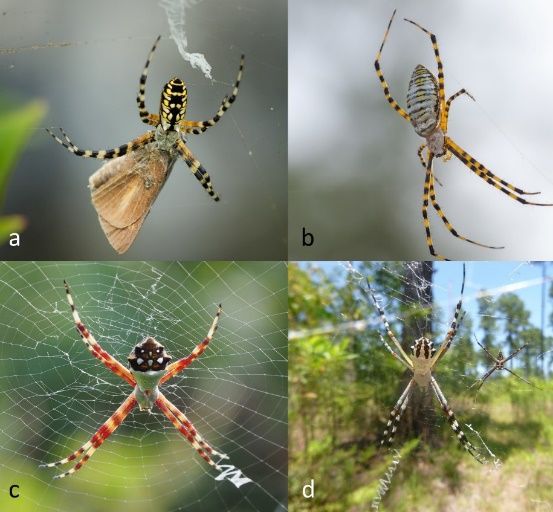
Credit: (a, b) Daniel Dye, (c) iNaturalist user zygy (CC0), and (d) iNaturalist user cwarneke (CC0).
Spiny-backed orb weaver (Gasteracantha cancriformis)
The spiny-backed orb weaver (Gasteracantha cancriformis) is adorned with colorful spiny projections. These spiders feast on mosquitoes and other small insects that are captured in their orb webs (Muma 1971). Orb webs are generally defined as two-dimensional circular webs that resemble wheels; webs are made from silk that comes from the spinnerets (pair of posterior appendages). The species name “cancriformis” means “crab shaped” because of the resemblance of the spiders’ abdomen to the carapace of a crab (Figure 2). Despite their name’s meaning, they should not be confused with crab spiders in the family Thomisidae, which don’t live in orb webs (see Figure 20 below) (Edwards 2000a). The spiny-backed orb weaver is widespread: it is found in North, Central, and South America and is established in Hawaii (Suman 1964; Chamberland et al. 2020).

Credit: Erin C. Powell, FDACS-DPI
Bolas spiders (Mastophora sp.)
During the day, bolas spiders in the genus Mastophora rest on leaves mimicking bird poop (Figure 3a). At night, they use a special strategy to hunt their prey. Rather than building an orb web like most members of the family Araneidae, bolas spiders hunt using a ball of sticky glue (Figure 3b) that they swing from a silk line to catch moths (Yeargan 1994). Many species are known to mimic pheromones produced by female moths; these pheromones (airborne chemical signals used in communication) attract male moths that are out looking for mates. The spiders lure in these moths and capture them with their sticky bolas (Yeargan 1994).

Credit: Lisa A. Taylor, UF/IFAS
Golden silk orb weaver (Trichonephila clavipes)
The golden silk orb weaver (Trichonephila clavipes) is also commonly known as the banana spider in Florida. Their silk is particularly renowned for its golden hue and extreme strength among spiders (Vollrath 2000). Female golden silk orb weavers often have smaller spiders lurking in their webs, including tiny males that are a fraction of their size (Figure 4) (Elgar 1991; Weems Jr. and Edwards 2011). Another occupant often found in the web of T. clavipes are the small kleptoparasitic dewdrop spiders (Argyrodes sp.) that nibble on the prey left behind (Agnarsson 2003).
In some areas of Florida, the golden silk orb weaver is a preferred prey item of the spider-hunting mud dauber wasp, Sceliphron caementarium (Powell and Taylor 2017). These wasps capture and paralyze spider prey to feed their offspring.
Trichonephila clavipes was formerly known as Nephila clavipes until a taxonomic revision in 2019 (Kuntner et al. 2019); this outdated name is still commonly in use online and in books.
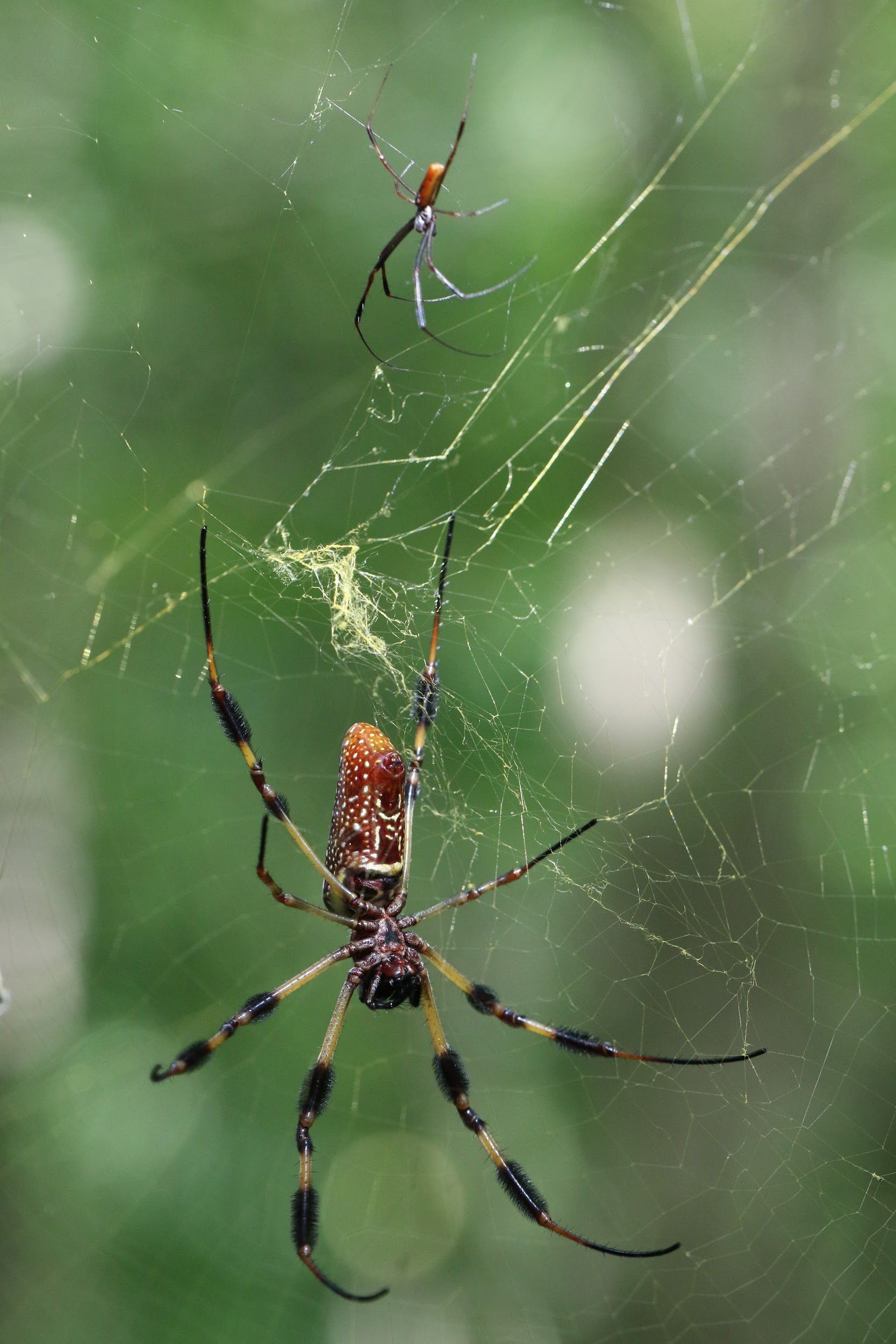
Credit: Lisa A. Taylor, University of Florida
Family Deinopidae
Ogre-faced spider (Deinopis spinosa)
Nocturnal ogre-faced spiders (Deinopis spinosa), sometimes known as “net-casting spiders,” have remarkably large posterior median eyes and an unusual hunting strategy: they spin a small, sticky net-like web that they hold in their front legs to grab prey at night (Figure 5a,b) (Stafstrom and Hebets 2016). When they aren’t hunting, they rest with their legs outstretched to resemble a stick (Figure 5c).
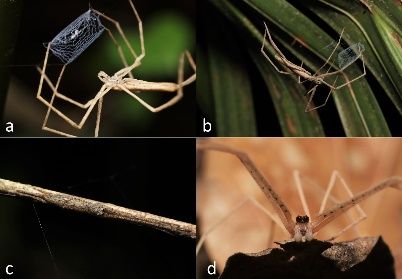
Credit: Erin C. Powell, FDACS-DPI
Family Filistatidae
Southern house spider (Kukulcania hibernalis)
Males and females of the southern house spider look very different from one another. Males are light brown and lanky (Figure 6a), while females are velvety dark brown with thicker bodies (Figure 6b) (Edwards and McCanless 2000). Males are often mistaken for brown recluses, but a closer look can help distinguish them: southern house spiders have eight eyes (brown recluses have only six), and they have very long pedipalps (appendages that extend from the face, almost appearing as an additional pair of legs) (Figure 6a). Kukulcania hibernalis often build their thick, messy webs in urban habitats, such as the corners of window eaves.
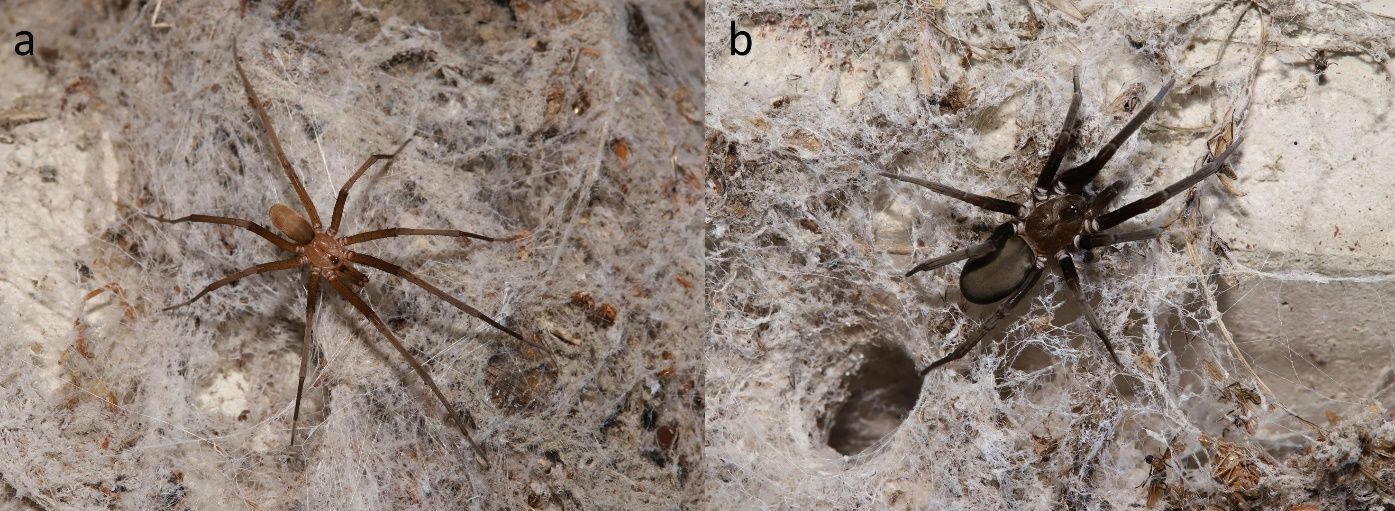
Credit: Erin C. Powell, FDACS-DPI
Family Lycosidae
Wolf spiders
Wolf spiders provide maternal care to their offspring—they are great moms (Higashi and Rovner 1975). After laying eggs, they diligently carry their egg sac behind them, attached to the spinnerets (silk-spinning appendages on their abdomens) (Figure 7a). If the female loses her egg sac for some reason (e.g., if it is eaten or damaged), she may even try to replace it with a pebble or another round object, even, in some cases, an isopod (the familiar tiny animal commonly known as “roly-poly” or “pill bug”) (Brown 2018). When their eggs hatch, they carry their spiderlings on their back until they are big enough to fend for themselves (Figure 7b). Wolf spiders are the only spiders in the world known to carry their offspring on their backs.

Credit: Erin C. Powell, FDACS-DPI
Family Mimetidae
Pirate spiders
Pirate spiders (Mimetidae) have a unique hunting technique to capture and eat other spiders. They creep into the webs of other spiders and use their legs to pluck on their silk lines. When the resident spider, expecting prey or a mate, comes out to investigate, the pirate launches a surprise attack and eats them (Jackson and Whitehouse 1986; Kloock 2001). While pirate spiders are known mostly to eat other spiders, they also consume some insect prey (Kloock 2001).
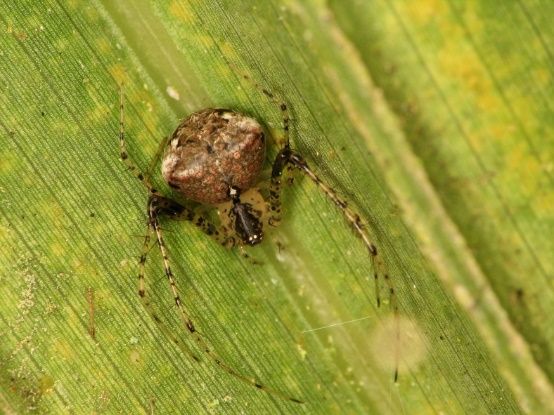
Credit: Sean McCann
Family Oxyopidae
Green lynx spider (Peucetia viridis)
Green lynx spiders are often found on vegetation where they sit and wait for prey (Figure 9a, Weems Jr. and Whitcomb 2004). These spiders have distinctive spiny setae (hairs) on their legs (Figure 9b). The green lynx spider is often green in color, as the common name suggests, but one of their most unique features is their ability to change color to match the background of their environment (Robertson et al. 1994). Scientists do not yet understand the mechanisms that allow them to change color, but individuals can be found in nature ranging from yellow to green to pink to purple (pers. obs.). Like many spider families, the lynx spiders have a distinct eye arrangement unique to the family Oxyopidae (Figure 9b).
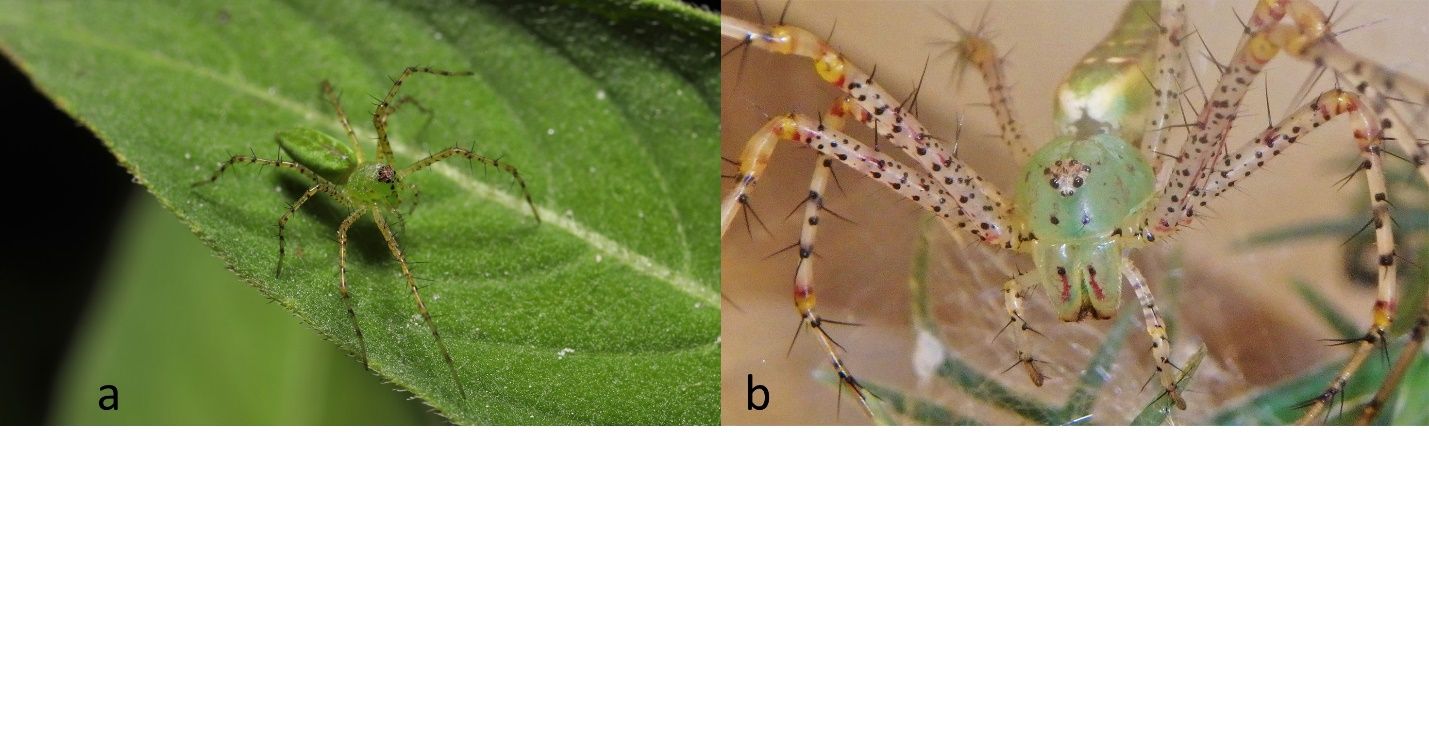
Credit: (a) Erin C. Powell, FDACS-DPI, (b) Samm Wehman Epstein
Family Pholcidae
Cellar spiders or daddy long legs spiders (Pholcus spp.)
The daddy long legs spiders, or cellar spiders, are often found in urban environments, such as the corners of homes, under eaves, and in sheds, cellars, basements, and attics (Figure 10). Cellar spiders build webs and capture a variety of insect prey (Figure 10b), but will also eat other spiders by invading their webs (Jackson and Brassington 1987). Cellar spiders should not be confused with harvestmen, which share the common name “daddy long legs.” Harvestmen are not spiders; they are in a different order of arachnids and have only a single body segment, no venom glands, and no silk glands to spin webs (Novak 2007). The pervasive myth that daddy long legs (referring to either spiders or harvestmen) are the most venomous spider but are unable to bite humans is untrue. Spiders in this family do have venom but it is only strong enough to affect their invertebrate prey (Zobel-Thropp et al. 2019).
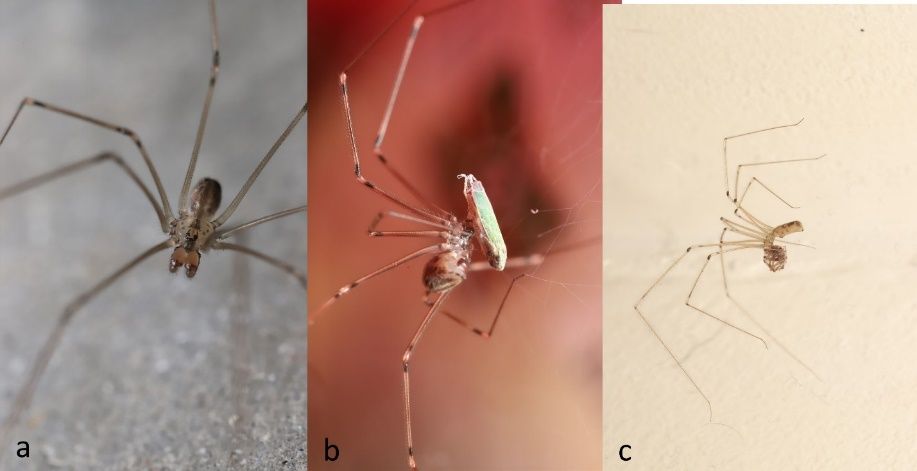
Credit: Erin C. Powell, FDACS-DPI
Family Pisauridae
Fishing spiders (Dolomedes spp.)
As their common name suggests, these spiders are often found in or near water sources. They are able to capture fish, frogs, and other small vertebrates but primarily eat invertebrates (Figure 11, Bleckmann and Lotz 1987, Zimmermann and Spence 1989). Female fishing spiders can be aggressive and kill potential mates, a phenomenon known as sexual cannibalism (Johnson and Sih 2005).
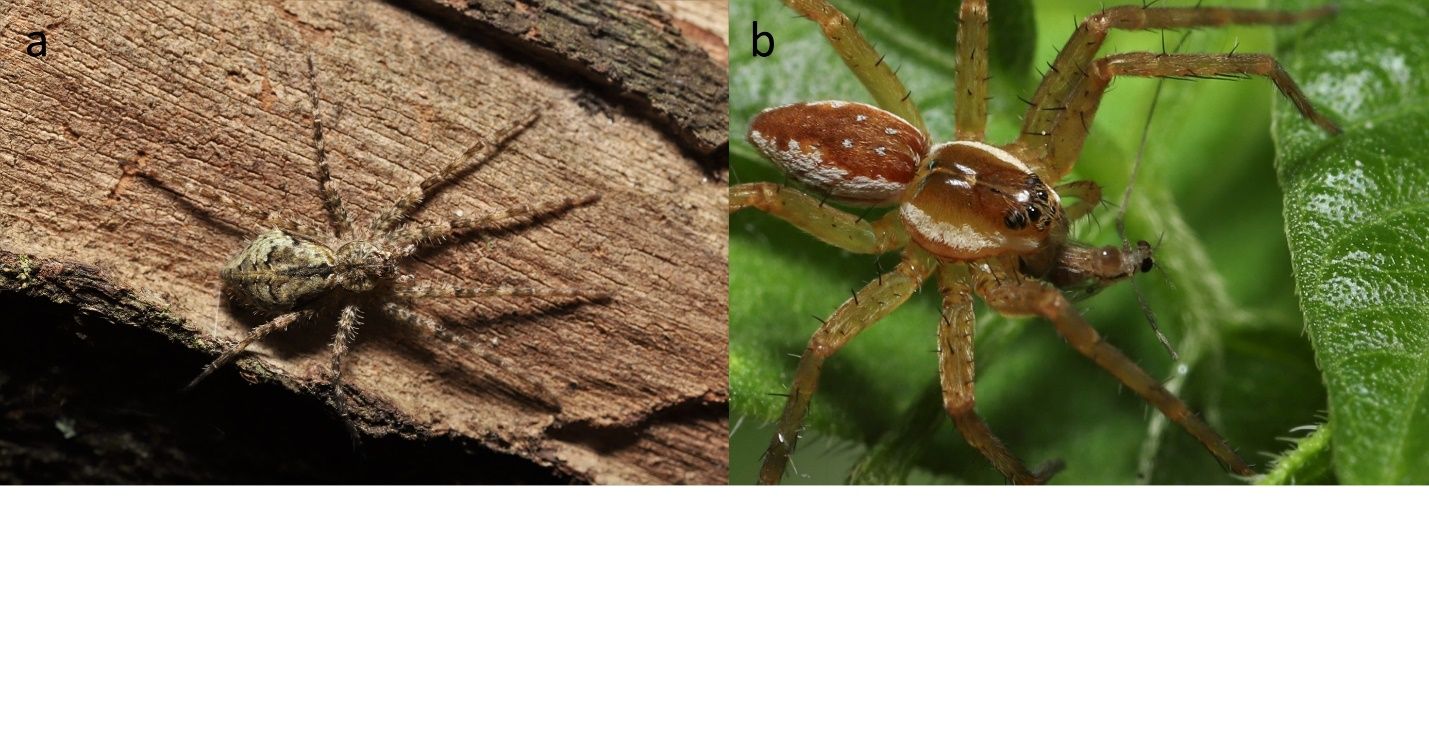
Credit: Erin C. Powell, FDACS-DPI
Family Salticidae
Habronattus jumping spiders
At least eleven species of tiny jumping spiders in the genus Habronattus can be found in Florida (Griswold 1987; Coco and Taylor 2017). Habronattus jumping spiders are common inhabitants of backyards, gardens, and organic farms. Like all jumping spiders (i.e., all members of the family Salticidae), Habronattus have enlarged, forward-facing eyes (known as the anterior median eyes) and exceptional vision (Harland and Jackson 2012, see Figure 12). Male Habronattus jumping spiders are known for their elaborate courtship dances that combine color, motion, and substrate-borne vibrations, all presumably to impress females (Elias et al. 2012; Taylor et al. 2014; Blackburn and Maddison 2015). This genus is also unique among jumping spiders for their enhanced color vision and the ability to see and discriminate colors ranging from ultraviolet to red (Zurek et al. 2015).
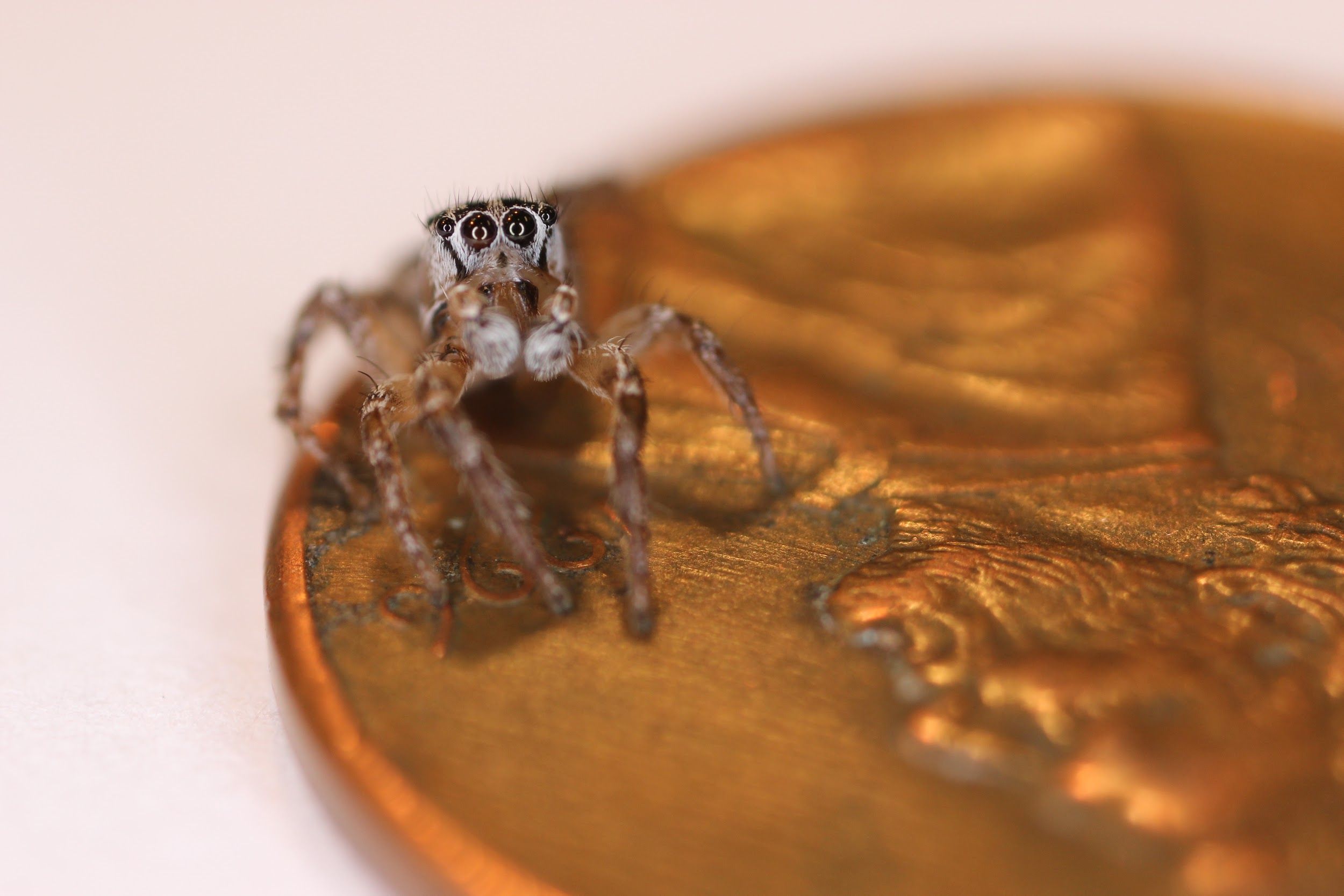
Credit: Lisa A. Taylor, University of Florida
Magnolia green jumping spider (Lyssomanes viridis)
Magnolia green jumping spiders are distinctive with their translucent green coloration (Figure 13). Males have striking red-orange jaws that they show off to other males in ritualized contests (fights) to win female mates (Figure 13b) (Tedore and Johnsen 2012). As their common name implies, magnolia green jumping spiders are commonly found on the leaves of magnolia trees. However, they are not restricted or specialized to magnolias or plants in general; they are found on sweetgum trees, palmettos (Richman and Whitcomb 1981), various other plants, and all manner of other things, such as cars and compost bins.
Though they look somewhat similar, magnolia green jumping spiders can be distinguished from the green lynx spiders described above by their huge,forward-facing eyes (characteristic of all jumping spiders) and the lack of long spines on the legs (see Figure 13 vs. Figure 9).
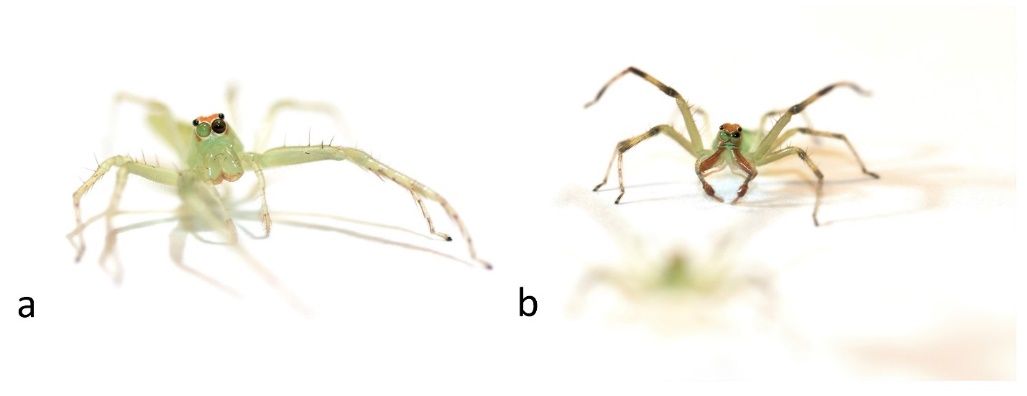
Credit: Lisa A. Taylor, UF/IFAS
Dimorphic jumping spider (Maevia inclemens)
Dimorphic jumping spider (Maevia inclemens) males come in two morphs, or forms, that occur together in the same population: the gray morph has striking zebra-striped legs and bright yellow pedipalps (Figure 14a), while the tufted morph has three black tufts of hair on his forehead (Figure 14b; Clark and Uetz 1993; Lietzenmayer and Taylor 2018). The existence of two different morphs of males within the same species is rare among spiders. In addition to the difference in appearance, these two male morphs even have different courtship dances that they use to impress females. The females look different than either of the male morphs: they are light tan to orange in color without tufts or leg stripes (Figure 14c).
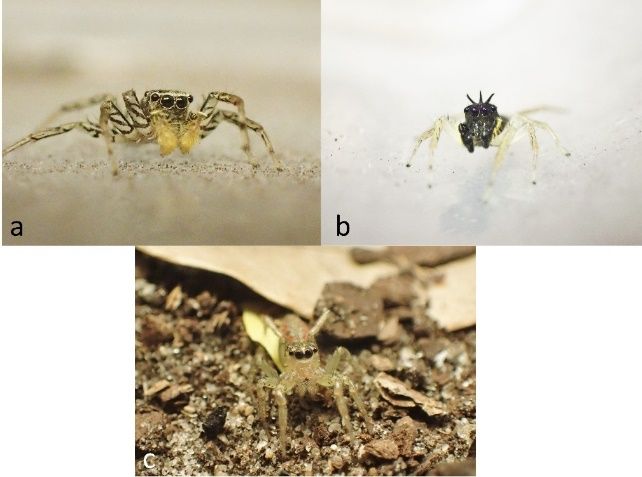
Credit: Laurel Lietzenmayer, UF/IFAS
Regal jumping spider (Phidippus regius)
Phidippus regius is one of the largest jumping spider species (Edwards 2000b). It is a voracious and cat-like predator that can take down prey much larger than itself, including small frogs and lizards (Nyffeller et al. 2017). However, these huge meals are exceptional, and this species' diet consists mostly of insect prey (Edwards 1990). Males and females are very different in color. Both sexes have white markings, but females can be either orange, grey, or brown (Figure 15b), while males are always black (Figure 15a).

Credit: Erin C. Powell, FDACS-DPI
Family Scytodidae
Spitting spiders (Scytodes spp.)
Spitting spidersare known for a unique hunting trick: they spit a sticky glue on their prey to pin them down before attack (Gilbert and Rayor 1985). This substance is a mixture of silk, glue, and venom that is made within the venom glands (Suter and Stratton 2009). Spitting spiders are also attentive mothers: they carry their egg sac in their jaws as the baby spiders (spiderlings) develop inside (Li et al. 1999). During this time, with their jaws preoccupied, they are unable to hunt or defend themselves (Li et al. 1999). After hatching, spiderlings remain in the mother’s web for a while before dispersing to build their own webs (Li et al. 1999). Spitting spiders can identified by their domed carapace and having only six eyes (unlike most other large spiders, which usually have eight eyes) (Figure 16).
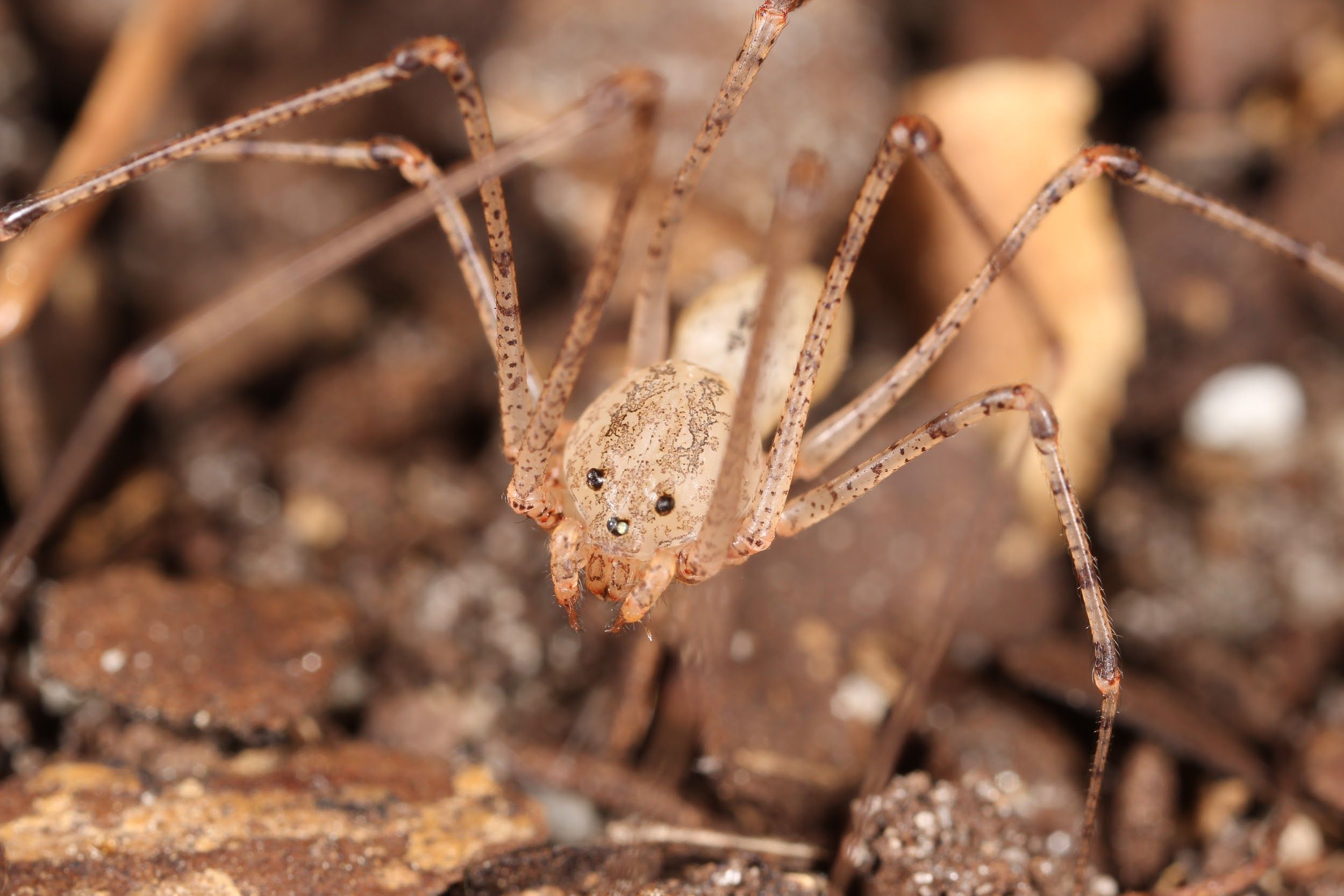
Credit: Lisa A. Taylor, UF/IFAS
Family Sicariidae
Recluse spiders (Loxosceles spp.)
There is currently no scientific evidence to suggest that any recluse spider is established in Florida (Edwards 2001; Vetter et al. 2004), but we include them here because many people mistakenly believe that they are common in Florida (Edwards 2003). Three species of Loxosceles have occasionally been intercepted in Florida: brown recluse (Loxosceles reclusa), Chilean recluse (Loxosceles rufescens), and Mediterranean recluse (Loxosceles laeta) (Figure 17). Countless myths, rumors, and stories surround recluse spiders. Mystery bites and wounds and bacterial infections that require treatment with antibiotics are commonly misdiagnosed as recluse bites by the public, by doctors, and by veterinarians, none of which are trained in spider identification (Vetter et al. 2004). Without directly seeing the spider inflict the bite, it is difficult to accurately determine that such injuries are caused by a spider at all.
Recluses can be distinguished from other commonly encountered spiders by having only 6 eyes (unlike the more usual pattern of 8 eyes) and a dark violin-shaped pattern on their relatively flat cephalothorax (head), though the violin pattern is not always consistent and should not be relied upon for identification. They also have long, slender legs and are relatively less hairy than other spiders that they are commonly confused with (e.g., wolf spiders [Figure 7], fishing spiders [Figure11], and male southern house spiders [Figure 6a]). They also have short pedipalps when compared with male southern house spiders (Figure 6a).
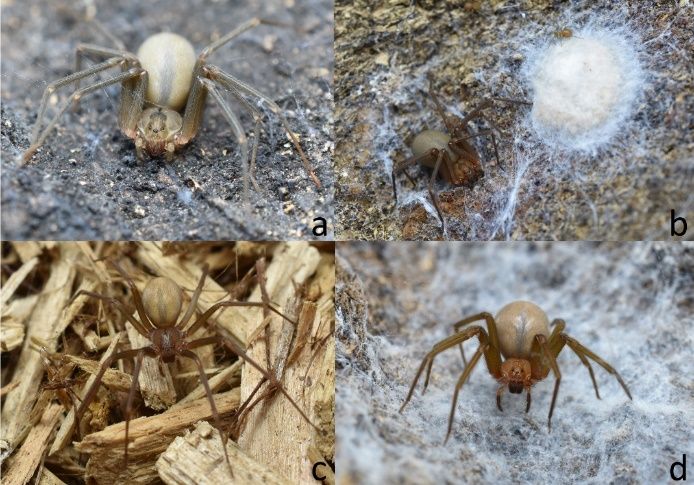
Credit: Lou Coticchio
Family Tetragnathidae
Orchard spiders or orchard orb weavers (Leucauge spp.)
These bright little spiders build orb webs from which they hang upside down (Figure 18) (Hall 2019). Two species are found in Florida, Leucauge argyrobapta and L. argyra (Ballesteros and Hormiga 2018). Leucauge argyrobapta has bright orange spots on the abdomen, while L. argyra does not. Orchard orb weavers are common and may be confused with widow spiders (see below) because of the bright orange dots on the abdomen. They are also sometimes misidentified as juvenile golden silk orb weavers (Trichonephila clavipes). Their orb web shape, color patterns, and thinner elongate abdomen distinguishes them from widow spiders their with messy cobwebs and bulbous round abdomens. Orchard orb weavers can be distinguished from golden silk orb weavers by their color pattern and lack of leg tufts (Figure 18 vs Figure 4).
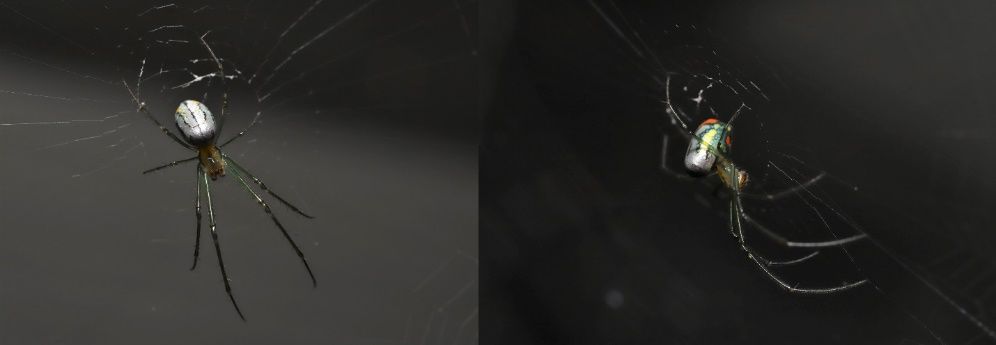
Credit: Erin C. Powell, FDACS-DPI
Family Theridiidae
Widow spiders (Latrodectus spp.)
The widow spiders found in Florida include the southern black widow (Latrodectus mactans), the brown widow (L. geometricus), the northern black widow (L. variolus), and the red widow (L. bishopi) (Edwards 2002; Eidenand Kaufman 2013). Widow spiders have characteristic red markings ontheir large round abdomens. They build a messy cobweb where they usually hang upside down (Figure 19). Widow spiders have medically significant venom, meaning people may require medical care if bitten (Bronstein et al. 2001). However, widow spiders are shy and non-aggressive, and bites rarely occur unless the spider is taunted or accidentally crushed/pinched in clothing (Edwards 2002).
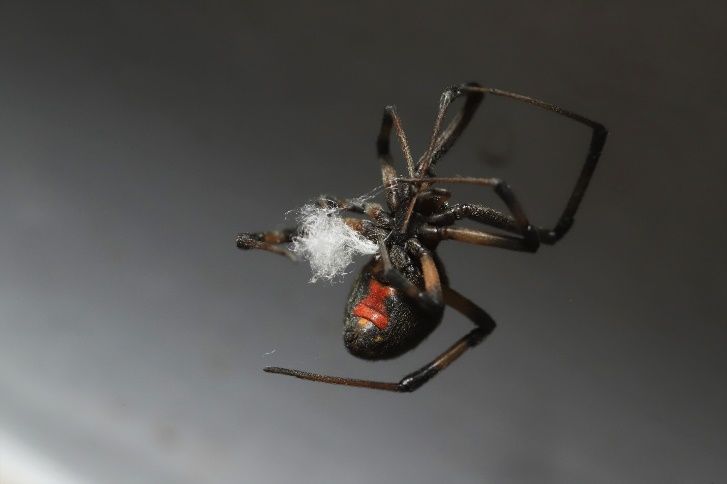
Credit: Erin C. Powell, FDACS-DPI
Thomisidae
Flower crab spiders (Mecaphesa, Misumena, Misumenoides, and Misumessus spp.)
Flower crab spiders come in a brilliant array of colors including white, orange, pink, and yellow (Figure 20a–c). These crab spiders are sit-and-wait hunters with a special strategy. They rest on flowers that match their color, and some can even change their own color to match their background, providing camouflage as they hunt for incoming pollinators such as bees, flies, and wasps (Figure 20c, Chittka 2001).
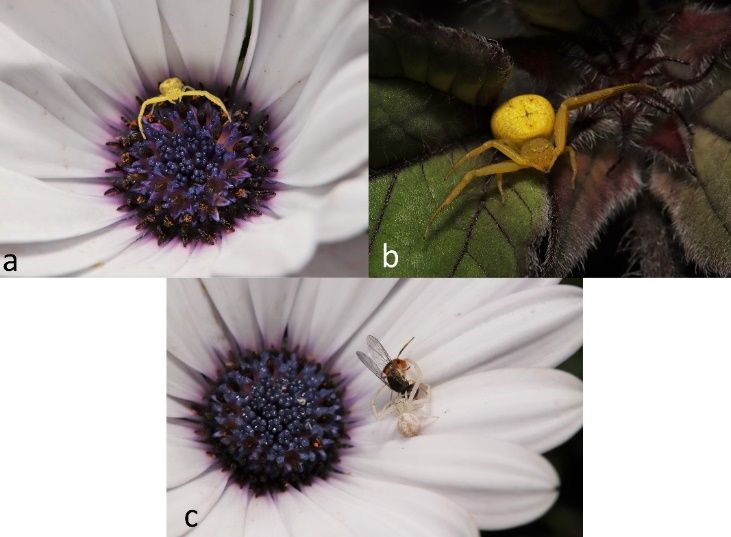
Credit: Erin C. Powell, FDACS-DPI
Family Uloboridae
Hackled orb weavers or cribellate orb weavers
The hackled orb weavers belong to the only family of spiders that lack venom glands, Uloboridae. They have a special type of silk called cribellate (hackled) silk with fine fuzzy fibers that help ensnare their prey (Figure 21). While members of this family build a typical spiralled orb web, their webs have a characteristically wooly appearance. When prey lands in their webs, they wrap it thoroughly. Even though they do not use venom to subdue their prey, they still must spit up digestive enzymes to pre-dissolve the prey before eating (Weng et al. 2006).

Credit: Lisa A. Taylor, University of Florida
Conclusions
Spiders are often misunderstood and underappreciated animals despite being important members of the ecosystem and generally harmless to humans. This fascinating group of arthropods has evolved an extraordinary diversity of behaviors, adaptations, web types, and coloration. The coloring book (https://edis.ifas.ufl.edu/publication/IN1390) associated with this publication is designed for people of all ages to learn about and appreciate spiders.
References
Abrenica-Adamat, L. R., C. B. C. de Asis, Z. S. N. Rebollo, and J. A. M. Batoon. 2015. “Testing the Prey Attraction Function of Stabilimenta in Orb-Webs of Argiope luzona and Argiope aemula (Araneae: Araneidae).” Extreme Life, Biospeology and Astrobiology 7:45–51.
Agnarsson, I. 2003. “Spider Webs as Habitat Patches—The Distribution of Kleptoparasites (Argyrodes, Theridiidae) among Host Webs (Nephila, Tetragnathidae).” The Journal of Arachnology 31:344–349. https://doi.org/10.1636/s02-21.
Ballesteros, J.A,. and G. Hormiga. 2018. Species Delimitation of the North American Orchard-Spider Leucauge venusta (Walckenaer 1841) (Araneae, Tetragnathidae). Molecular Phylogenetics and Evolution 121:183-197.
Blackburn, G. S., and W. P. Maddison. 2015. “Insights to the Mating Strategies of Habronattus americanus Jumping Spiders from Natural Behaviour and Staged Interactions in the Wild.” Behaviour 152:1169–1186. https://doi.org/10.1163/1568539X-00003273.
Blackledge, T. A. 1998. “Stabilimentum Variation and Foraging Success in Argiope aurantia and Argiope trifasciata (Araneae: Araneidae).” Journal of Zoology 246:21–27. https://doi.org/10.1111/j.1469-7998.1998.tb00128.x.
Bleckmann, H., and T. Lotz. 1987. “The Vertebrate-Catching Behaviour of the Fishing Spider Dolomedes Triton (Araneae, Pisauridae).” Animal Behaviour 35:641–651. https://doi.org/10.1016/S0003-3472(87)80100-8.
Bronstein, A. C., D. A. Spyker, L. R. Cantilena, J. L. Green, B. H. Rumack, and C. Dart. 2011. “2010 Annual Report of the American Association of Poison Control Centers’ National Poison Data System (NPDS): 28th Annual Report.” Clinical Toxicology 49:910–941. https://doi.org/10.3109/15563650.2011.635149.
Brown, C. A. 2018. “Roly-Poly Egg Sacs: Isopods Used as Replacement Egg Sacs by the Wolf Spider Pardosa valens (Araneae: Lycosidae).” Arachnology 17:439–440. https://doi.org/10.13156/arac.2017.17.8.439.
Chamberland, L., F. C. Salgado-Roa, A. Basco, A. Crastz-Flores, G. J. Binford, and I. Agnarsson. 2020. “Phylogeography of the Widespread Caribbean Spiny Orb Weaver Gasteracantha cancriformis.” PeerJ 8:e8976. https://doi.org/10.7717/peerj.8976.
Chittka, L. 2001. “Camouflage of Predatory Crab Spiders on Flowers and the Colour Perception of Bees (Aranida: Thomisidae/Hymenoptera: Apidae).” Entomologia Generalis 25:181–187. https://doi.org/10.1127/entom.gen/25/2001/181.
Clark, D. L., and G. W. Uetz. 1993. “Signal Efficacy and the Evolution of Male Dimorphism in the Jumping Spider, Maevia inclemens.” Proceedings of the National Academy of Sciences 90:11954–11957. https://doi.org/10.1073/pnas.90.24.11954.
Coco, J., and L. A. Taylor. 2017. “Habronattus Jumping Spiders Habronattus (Pickard-Cambridge, 1901) (Arachnida: Araneae: Salticidae).” EENY683/IN1177. EDIS 2017 (4): 5. https://doi.org/10.32473/edis-in1177-2017.
Edwards, G. B. 1990. “Anecdotal Field Notes on Florida Phidippus (Araneae: Salticidae), with Notes on Territoriality in P. regius.” Peckhamia 2:96–100.
Edwards, G. B. 2000a. “A Spiny Orb Weaver Spider, Gasteracantha cancriformis (Linnaeus) (Arachnida: Araneae: Araneidae).” EENY-167/IN324. EDIS 2004 (2). https://doi.org/10.32473/edis-in324-2000.
Edwards, G. B. 2000b. “Regal Jumping Spider, Phidippus regius CL Koch (Arachnida: Salticidae).” EENY152/IN309 EDIS 2003 (15). https://doi.org/10.32473/edis-in309-2000.
Edwards, G. B. 2001. “The Present Status and a Review of the Brown Recluse and Related Spiders, Loxosceles spp. (Araneae: Sicariidae), in Florida.” Fla. Department Agric. & Consumer Services, Division of Plant Industry. Entomology Circular No. 406. https://www.fdacs.gov/content/download/9810/file/ent406.pdf.
Edwards, G. B. 2002. “Venomous Spiders in Florida.” Pest Alert. Florida Department of Agriculture and Consumer Services, Division of Plant Industry. https://www.fdacs.gov/content/download/68176/file/pest_alert_-_venomous_spiders_-_widow_and_recluse.pdf.
Edwards, G. B. 2003. “Brown Recluse Spider, Loxosceles reclusa Gertsch and Mulaik (Arachnida: Araneae: Sicariidae).” EENY-299/IN576. EDIS 2005 (1). https://doi.org/10.32473/edis-in576-2003.
Edwards, G. B., and S. Marshall. 2002. Florida’s Fabulous Spiders. World Publications, DBA National Art Service.
Edwards, G. B., and K. McCanless. 2000. “Southern House Spider, Kukulcania hibernalis (Hentz) (Arachnida: Araneae: Filistatidae).” EENY144/IN301. EDIS 2003 (14). https://doi.org/10.32473/edis-in301-2003.
Eiden, A., and P. E. Kaufman. 2013. Southern Black Widow Latrodectus mactans (Fabricius) (Arachnida: Araneae: Theridiidae).” EENY560/IN1000. EDIS 2013 (8). https://doi.org/10.32473/edis-in1000-2013.
Eisner T., and S. Nowicki. 1983. “Spider Web Protection through Visual Advertisement—Role of the Stabilimentum.” Science 219:185–187. https://doi.org/10.1126/science.219.4581.185.
Elgar, M. A. 1991. “Sexual Cannibalism, Size Dimorphism, and Courtship Behavior in Orb-Weaving Spiders (Araneidae).” Evolution 45:444–448. https://doi.org/10.1111/j.1558-5646.1991.tb04419.x.
Elias, D. O., W. P. Maddison, C. Peckmezian, M. B. Girard, and A. C. Mason. 2012. “Orchestrating the Score: Complex Multimodal Courtship in the Habronattus coecatus Group of Habronattus Jumping Spiders (Araneae: Salticidae).” Biological Journal of the Linnean Society 105:522–47. https://doi.org/10.1111/j.1095-8312.2011.01817.x.
Foelix, R. 2011. Biology of spiders. Oxford University Press. USA.
Gilbert, C., and L. S. Rayor. 1985. “Predatory Behavior of Spitting Spiders (Araneae: Scytodidae) and the Evolution of Prey Wrapping.” Journal of Arachnology 13:231–241.
Griffith, T. B., and J. L. Gillett-Kaufman. 2019. “Yellow Garden Spider, Writing Spider Argiope aurantia (Lucas) (Arachnida: Araneae: Araneidae).” EENY743/IN1273. EDIS 2020 (3). https://doi.org/10.32473/edis-in1273-2019.
Griswold, C. E. 1987. “A Revision of the Jumping Spider Genus Habronattus F.O.P. Cambridge (Araneae: Salticidae), with Phenitic and Cladistic Analysis.” University of California Publications in Entomology 107:1–344.
Hall, D. 2019. “Orchard Orbweaver, Orchard Spider Leucauge argyrobapta (White), Leucauge venusta (Walckenaer) (Arachnida: Araneae: Tetragnathidae).” EENY728/IN1243. EDIS 2019 (2). https://doi.org/10.32473/edis-in1243-2019.
Harland, D. P., D. Li, and R. R. Jackson. 2012. “How Jumping Spiders See the World.” In How Animals See the World: Comparative Behavior, Biology, and Evolution of Vision, edited byO. F. Lazareva, T. Shimizu, and E. A. Wasserman (p. 133–163). Oxford University Press.
Higashi, G. A., and J. S. Rovner. 1975. “Post-Emergent Behaviour of Juvenile Lycosid Spiders.” Bulletin of the British Arachnological Society. 3:113–9.
Jackson, R. R., and R. J. Brassington. 1987. The Biology of Pholcus phalangioides (Araneae, Pholcidae): Predatory Versatility, Araneophagy and Aggressive Mimicry.” Journal of Zoology 211:227–238. https://doi.org/10.1111/j.1469-7998.1987.tb01531.x.
Jackson, R. R., and M. E. Whitehouse. 1986. “The Biology of New Zealand and Queensland Pirate Spiders (Araneae, Mimetidae): Aggressive Mimicry, Araneophagy and Prey Specialization.” Journal of Zoology 210:279–303. https://doi.org/10.1111/j.1469-7998.1986.tb03635.x.
Johnson, J. C., and A. Sih. 2005. “Precopulatory Sexual Cannibalism in Fishing Spiders (Dolomedes triton): A Role for Behavioral Syndromes.” Behavioral Ecology and Sociobiology 58:390–396. https://doi.org/10.1007/s00265-005-0943-5.
Kloock, C. T. 2001. “Diet and Insectivory in the “Araneophagic” Spider, Mimetus notius (Araneae: Mimetidae).” The American Midland Naturalist 146:424–428. https://doi.org/10.1674/0003-0031(2001)146[0424:DAIITA]2.0.CO;2.
Kuntner, M., C. A. Hamilton, R. C. Cheng, M. Gregorič, N. Lupše, T. Lokovšek, E. Lemmon, A. Lemmon, I. Agnarsson, J. Coddington, and J. E. Bond. 2019. “Golden Orbweavers Ignore Biological Rules: Phylogenomic and Comparative Analyses Unravel a Complex Evolution of Sexual Size Dimorphism.” Systematic Biology 68: 555–572. https://doi.org/10.1093/sysbio/syy082.
Li, D., R. R. Jackson, and A. T. Barrion. 1999. “Parental and Predatory Behaviour of Scytodes sp., an Araneophagic Spitting Spider (Araneae: Scytodidae) from the Philippines.” Journal of Zoology 247:293–310. https://doi.org/10.1111/j.1469-7998.1999.tb00993.x.
Lietzenmayer, L., and L. Taylor. 2018. “Dimorphic Jumper Maevia inclemens (Walckenaer 1837) (Arachnida: Araneae: Salticidae).” EENY-702/IN1209. EDIS 2018 (2). https://doi.org/10.32473/edis-in1209-2018.
Muma, M. H. 1971. “Biological and Behavioral Notes on Gasteracantha cancriformis (Arachnida: Araneidae).” Florida Entomologist 54:345–351. https://doi.org/10.2307/3493600.
Novak, T. 2007. Harvestmen: The Biology of Opiliones. Harvard University Press.
Nyffeler, M., G. B. Edwards, and K. L. Krysko. 2017. “A Vertebrate-Eating Jumping Spider (Araneae: Salticidae) from Florida, USA.” The Journal of Arachnology 45:238–241. https://doi.org/10.1636/JoA-17-011.1.
Powell, E. C., and L. A. Taylor. 2017. “Specialists and Generalists Coexist within a Population of Spider-Hunting Mud Dauber Wasps.” Behavioral Ecology 28:890–898. https://doi.org/10.1093/beheco/arx050.
Richman, D. B., and W. H. Whitcomb. 1981. “The Ontogeny of Lyssomanes viridis (Walckenaer)(Araneae: Salticidae) on Magnolia grandiflora L.” Psyche: A Journal of Entomology 88:127–133. https://doi.org/10.1155/1981/85970
Robertson, M. W., P. H. Adler, and J. W. McCreadie. 1994. “Colour Change in the Green Lynx Spider, Peucetia viridans (Araneae: Oxyopidae).” Bulletin of the British Arachnological Society 9:290–92.
Stafstrom, J. A., and E. A. Hebets. 2016. “Nocturnal Foraging Enhanced by Enlarged Secondary Eyes in a Net-Casting Spider.” Biology Letters 12:20160152. https://doi.org/10.1098/rsbl.2016.0152.
Suman, T. W. 1964. “Spiders of the Hawaiian Islands: Catalog and Bibliography.” Pacific Insects 6:665–687.
Suter, R. B., and G. E. Stratton. 2009. “Spitting Performance Parameters and Their Biomechanical Implications in the Spitting Spider, Scytodes thoracica.” Journal of Insect Science 9:62. https://doi.org/10.1673/031.009.6201.
Taylor, L. A., D. L. Clark, and K. J. McGraw. 2014. “Natural Variation in Condition-Dependent Display Colour Does Not Predict Male Courtship Success in a Jumping Spider.” Animal Behaviour 93:267–278. https://doi.org/10.1016/j.anbehav.2014.05.005.
Tedore, C., and S. Johnsen. 2012. “Weaponry, Color, and Contest Success in the Jumping Spider Lyssomanes viridis.” Behavioural Processes 89:203–211. https://doi.org/10.1016/j.beproc.2011.10.017.
Vetter, R. S., G. B. Edwards, and L. F. James. 2004. “Reports of Envenomation by Brown Recluse Spiders (Araneae: Sicariidae) Outnumber Verifications of Loxosceles Spiders in Florida.” Journal of Medical Entomology 41:593–597. https://doi.org/10.1603/0022-2585-41.4.593.
Vollrath, F. 2000. “Strength and Structure of Spiders’ Silks.” Reviews in Molecular Biotechnology 74:67–83. https://doi.org/10.1016/S1389-0352(00)00006-4.
Yeargan, K. V. 1994. “Biology of Bolas Spiders.” Annual Review of Entomology 39:81–99. https://doi.org/10.1146/annurev.en.39.010194.000501.
Weng, J. L., G. Barrantes, and W. G. Eberhard. 2006. “Feeding by Philoponella vicina (Araneae, Uloboridae) and How Uloborid Spiders Lost Their Venom Glands.” Canadian Journal of Zoology 84:1752–1762. https://cdnsciencepub.com/doi/10.1139/z06-149.
Wise, D. H. 1995. Spiders in Ecological Webs. Cambridge University Press. https://doi.org/10.1017/CBO9780511623431.
Weems Jr, H. V., and G. B. Edwards. 2011. “Golden Silk Spider, Trichonephila clavipes (Linnaeus) (Arachnida: Araneae: Tetragnathidae).” EENY229/IN467. EDIS 2020. https://edis.ifas.ufl.edu/publication/in467.
Weems Jr, H. V., and W. H. Whitcomb. 2004. “Green Lynx Spider, Peucetia viridans (Hentz) (Arachnida: Araneae: Oxyopidae).” EENY249/IN521. EDIS 2004 (11). https://doi.org/10.32473/edis-in521-2001.
Zimmermann, M., and J. R. Spence. 1989. “Prey Use of the Fishing Spider Dolomedes triton (Pisauridae, Araneae): An Important Predator of the Neuston Community.” Oecologia 80:187–194. https://doi.org/10.1007/BF00380149.
Zobel-Thropp, P. A., J. R. Mullins, C. Kristensen, B. Kronmiller, C. L. Davis, L. A. Breci, and G. J. Binford. 2019. “Not So Dangerous After All? Venom Composition and Potency of the Pholcid (Daddy Long-Leg) Spider Physocyclus mexicanus.” Frontiers in Ecology and Evolution 7:256. https://doi.org/10.3389/fevo.2019.00256.
Zurek, D. B., T. W. Cronin, L. A. Taylor, K. Byrne, M. L. Sullivan, and N. I. Morehouse. 2015. “Spectral Filtering Enables Trichromatic Vision in Colorful Jumping Spiders.” Current Biology 25:R403–R404. https://doi.org/10.1016/j.cub.2015.03.033.